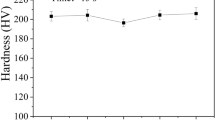Abstract
The surface quality of the stainless steel affects the efficiency of flexible photovoltaics. Chemical mechanical polishing (CMP) is a finishing process that is used to prepare substrates for electronic devices. The CMP slurry composition is an important factor because additives in the slurry generally improve the polishing performance. However, it is limited to find the optimum conditions for the slurry by only experimental approaches. Thus, this study uses electrochemical analysis and friction monitoring to examine the effects of the abrasive, oxidizer, chelating agent, and pH. Electrochemical and monitoring analysis are useful for validating predictions and understanding interactions between the slurry and the stainless steel surface. Good correspondence was found between the predictions and the polishing results in more accurate. The corrosion rate (CR) obtained from the potentiodynamic polarization curve is proportional to the experimental results, as is the behavior of the curve and the coefficient of friction (COF). After only 3 min CMP, the best performing slurry (abrasive 39 wt %, oxalic acid 1 wt %, H2O2 0.03 wt %, pH 1.5) improved the surface quality of 304 stainless steel by 4 nm. As a result, the proposed methods could help reduce the risks involved in stainless steel CMP slurry and these results could provide a reference for optimizing CMP slurry for flexible 304 stainless steel substrates.
Similar content being viewed by others
References
Lee, H., Lee, D., and Jeong, H., Mechanical aspects of the chemical mechanical polishing process: a review, Int. J. Precis. Eng. Manuf., 2016, vol. 17, no. 4, pp. 525–536.
Totolin, V., Göcerler, H., Rodríguez Ripoll, M., and Jech, M., Tribo-electrochemical study of stainless steel surfaces during chemical-mechanical polishing, Lubr. Sci., 2016, vol. 28, no. 6, pp. 363–380.
Lee, S., Chen, Y., Liu, C.P., and Fan, T.J., Electrochemical mechanical polishing of flexible stainless steel substrate for thin-film solar cells, Int. J. Electrochem. Sci., 2013, vol. 8, no. 2, pp. 6878–6888.
Jiang, L., He, Y., Yang, Y., and Luo, J., Chemical mechanical polishing of stainless steel as solar cell substrate, ECS J. Solid State Sci. Technol., 2015, vol. 4, no. 5, pp. 162–170.
Park, B., Lee, H., Kim, Y., Kim, H., and Jeong, H., Effect of process parameters on friction force and material removal in oxide chemical mechanical polishing, Jpn. J. Appl. Phys., 2008, vol. 47, no. 12, pp. 8771–8778.
Zhang, Z., Liu, W., and Song, Z., Effect of abrasive particle concentration on preliminary chemical mechanical polishing of glass substrate, Microelectron. Eng., 2010, vol. 87, no. 11, pp. 2168–2172.
Lee, D., Lee, H., and Jeong, H., Slurry components in metal chemical mechanical planarization (CMP) process: a review, Int. J. Precis. Eng. Manuf., 2016, vol. 17, no. 12, pp. 1751–1762.
Gorantla, V.R., Goia, D., Matijevic, E., and Babu, S., Role of amine and carboxyl functional groups of complexing agents in slurries for chemical mechanical polishing of copper, J. Electrochem. Soc., 2005, vol. 152, no. 12, pp. 912–916.
Wang, Y. and Zhao, Y., Modeling the effects of oxidizer, complexing agent and inhibitor on material removal for copper chemical mechanical polishing, Appl. Surf. Sci., 2007, vol. 254, no. 5, pp. 1517–1523.
Jiang, L., He, Y., and Luo, J., Effects of pH and oxidizer on chemical mechanical polishing of AISI 1045 steel, Tribol. Lett., 2014, vol. 56, no. 2, pp. 327–335.
Pohjanne, P., Vepsäläinen, M., Saario, T., Sipilä, K., Romu, J., Saukkonen, T., Hänninen, H., Heikkilä, M., Koskiniemi, J., and Berg, C.-G., Effect of electrochemical potential on stress corrosion cracking susceptibility of EN1.4301 (AISI 304) austenitic stainless steels in simulated hot black liquor, Corrosion, 2015, vol. 71, no. 7, pp. 887–894.
Wijesinghe, T.S.L. and Blackwood, D., Characterization of passive films on 300 series stainless steels, Appl. Surf. Sci., 2006, vol. 253, no. 2, pp. 1006–1009.
Author information
Authors and Affiliations
Corresponding author
Additional information
The article is published in the original.
About this article
Cite this article
Lee, D., Kim, H., Pak, B. et al. Electrochemical Analysis of the Slurry Composition for Chemical Mechanical Polishing of Flexible Stainless-Steel Substrates. J. Frict. Wear 38, 482–489 (2017). https://doi.org/10.3103/S1068366617060083
Received:
Published:
Issue Date:
DOI: https://doi.org/10.3103/S1068366617060083




